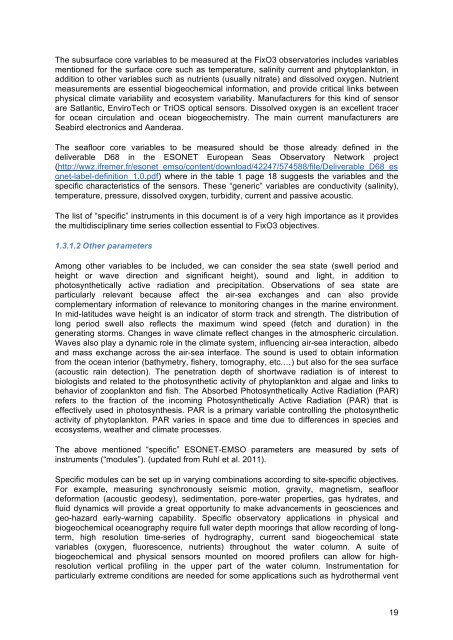Handbook of best practices
Handbook%20of%20best%20practices
Handbook%20of%20best%20practices
You also want an ePaper? Increase the reach of your titles
YUMPU automatically turns print PDFs into web optimized ePapers that Google loves.
The subsurface core variables to be measured at the FixO3 observatories includes variables<br />
mentioned for the surface core such as temperature, salinity current and phytoplankton, in<br />
addition to other variables such as nutrients (usually nitrate) and dissolved oxygen. Nutrient<br />
measurements are essential biogeochemical information, and provide critical links between<br />
physical climate variability and ecosystem variability. Manufacturers for this kind <strong>of</strong> sensor<br />
are Satlantic, EnviroTech or TriOS optical sensors. Dissolved oxygen is an excellent tracer<br />
for ocean circulation and ocean biogeochemistry. The main current manufacturers are<br />
Seabird electronics and Aanderaa.<br />
The seafloor core variables to be measured should be those already defined in the<br />
deliverable D68 in the ESONET European Seas Observatory Network project<br />
(http://wwz.ifremer.fr/esonet_emso/content/download/42247/574588/file/Deliverable_D68_es<br />
onet-label-definition_1.0.pdf) where in the table 1 page 18 suggests the variables and the<br />
specific characteristics <strong>of</strong> the sensors. These “generic” variables are conductivity (salinity),<br />
temperature, pressure, dissolved oxygen, turbidity, current and passive acoustic.<br />
The list <strong>of</strong> “specific” instruments in this document is <strong>of</strong> a very high importance as it provides<br />
the multidisciplinary time series collection essential to FixO3 objectives.<br />
1.3.1.2 Other parameters<br />
Among other variables to be included, we can consider the sea state (swell period and<br />
height or wave direction and significant height), sound and light, in addition to<br />
photosynthetically active radiation and precipitation. Observations <strong>of</strong> sea state are<br />
particularly relevant because affect the air-sea exchanges and can also provide<br />
complementary information <strong>of</strong> relevance to monitoring changes in the marine environment.<br />
In mid-latitudes wave height is an indicator <strong>of</strong> storm track and strength. The distribution <strong>of</strong><br />
long period swell also reflects the maximum wind speed (fetch and duration) in the<br />
generating storms. Changes in wave climate reflect changes in the atmospheric circulation.<br />
Waves also play a dynamic role in the climate system, influencing air-sea interaction, albedo<br />
and mass exchange across the air-sea interface. The sound is used to obtain information<br />
from the ocean interior (bathymetry, fishery, tomography, etc.…) but also for the sea surface<br />
(acoustic rain detection). The penetration depth <strong>of</strong> shortwave radiation is <strong>of</strong> interest to<br />
biologists and related to the photosynthetic activity <strong>of</strong> phytoplankton and algae and links to<br />
behavior <strong>of</strong> zooplankton and fish. The Absorbed Photosynthetically Active Radiation (PAR)<br />
refers to the fraction <strong>of</strong> the incoming Photosynthetically Active Radiation (PAR) that is<br />
effectively used in photosynthesis. PAR is a primary variable controlling the photosynthetic<br />
activity <strong>of</strong> phytoplankton. PAR varies in space and time due to differences in species and<br />
ecosystems, weather and climate processes.<br />
The above mentioned “specific” ESONET-EMSO parameters are measured by sets <strong>of</strong><br />
instruments (“modules”). (updated from Ruhl et al. 2011).<br />
Specific modules can be set up in varying combinations according to site-specific objectives.<br />
For example, measuring synchronously seismic motion, gravity, magnetism, seafloor<br />
deformation (acoustic geodesy), sedimentation, pore-water properties, gas hydrates, and<br />
fluid dynamics will provide a great opportunity to make advancements in geosciences and<br />
geo-hazard early-warning capability. Specific observatory applications in physical and<br />
biogeochemical oceanography require full water depth moorings that allow recording <strong>of</strong> longterm,<br />
high resolution time-series <strong>of</strong> hydrography, current sand biogeochemical state<br />
variables (oxygen, fluorescence, nutrients) throughout the water column. A suite <strong>of</strong><br />
biogeochemical and physical sensors mounted on moored pr<strong>of</strong>ilers can allow for highresolution<br />
vertical pr<strong>of</strong>iling in the upper part <strong>of</strong> the water column. Instrumentation for<br />
particularly extreme conditions are needed for some applications such as hydrothermal vent<br />
19


